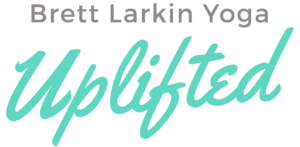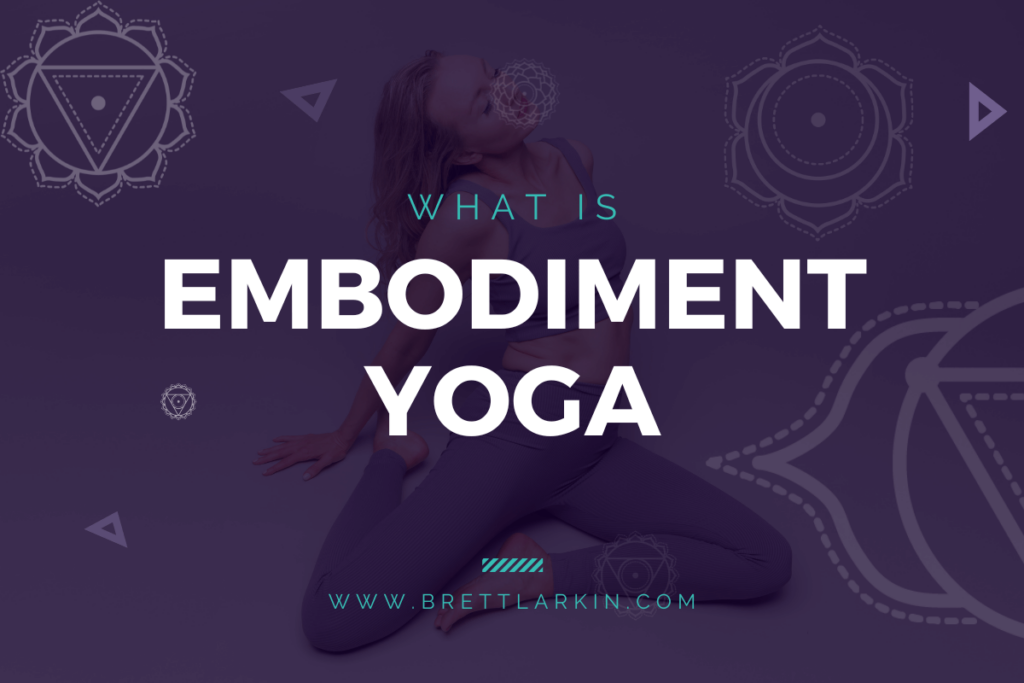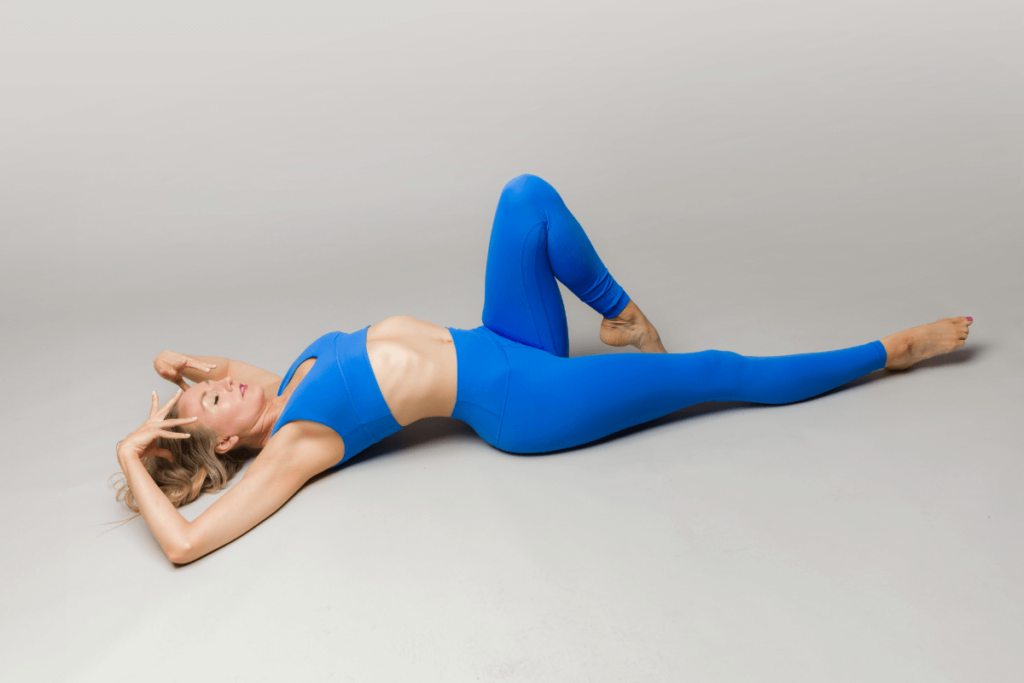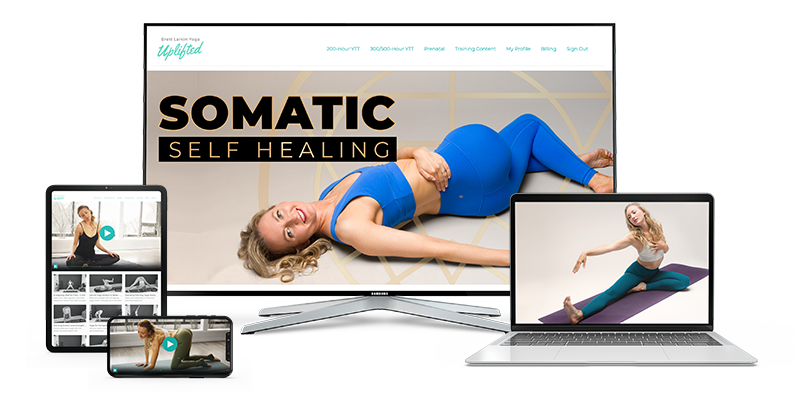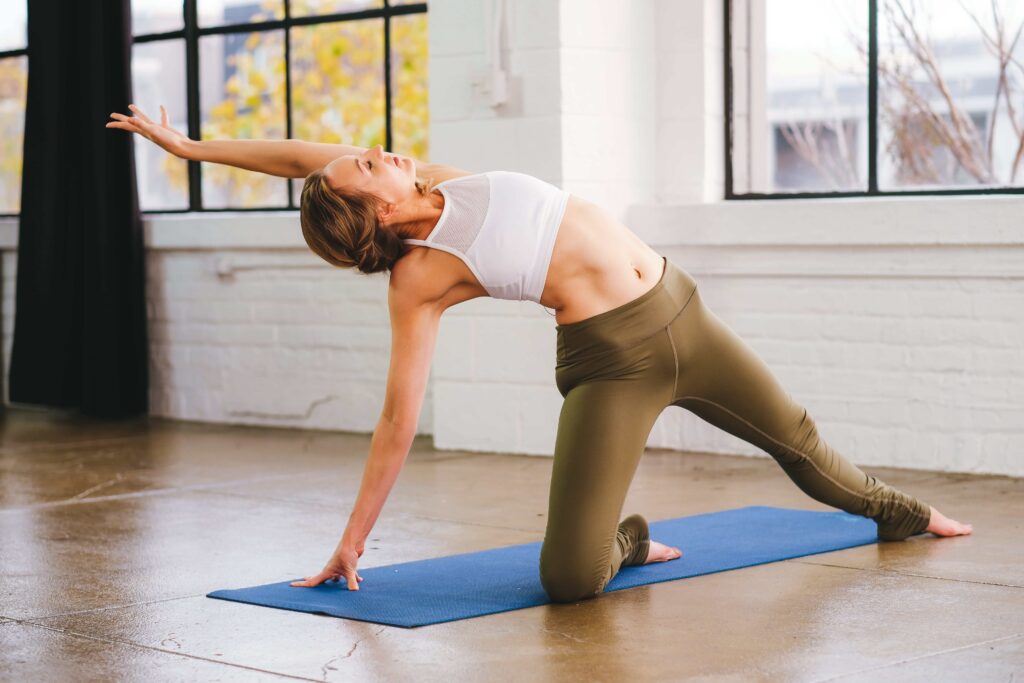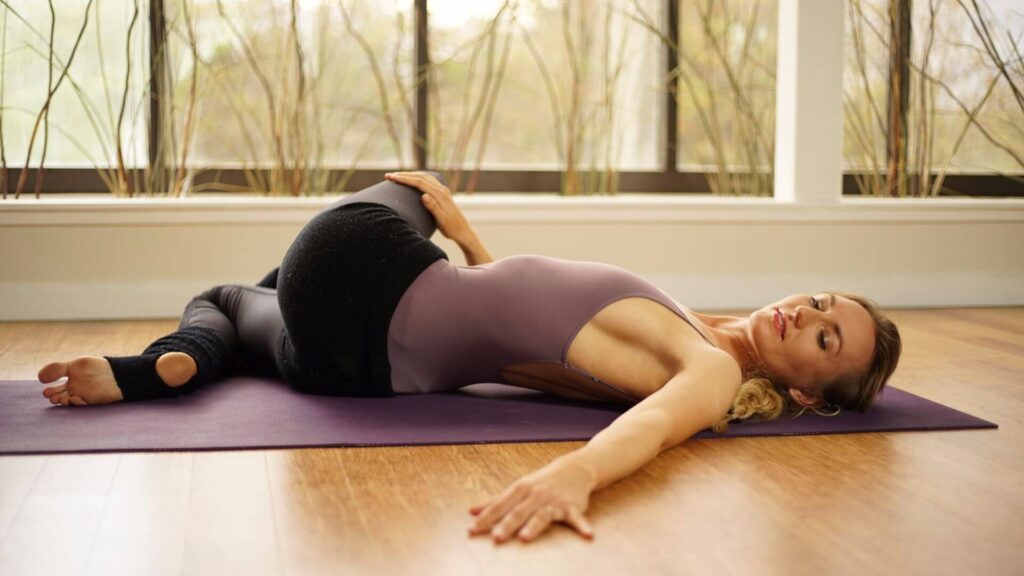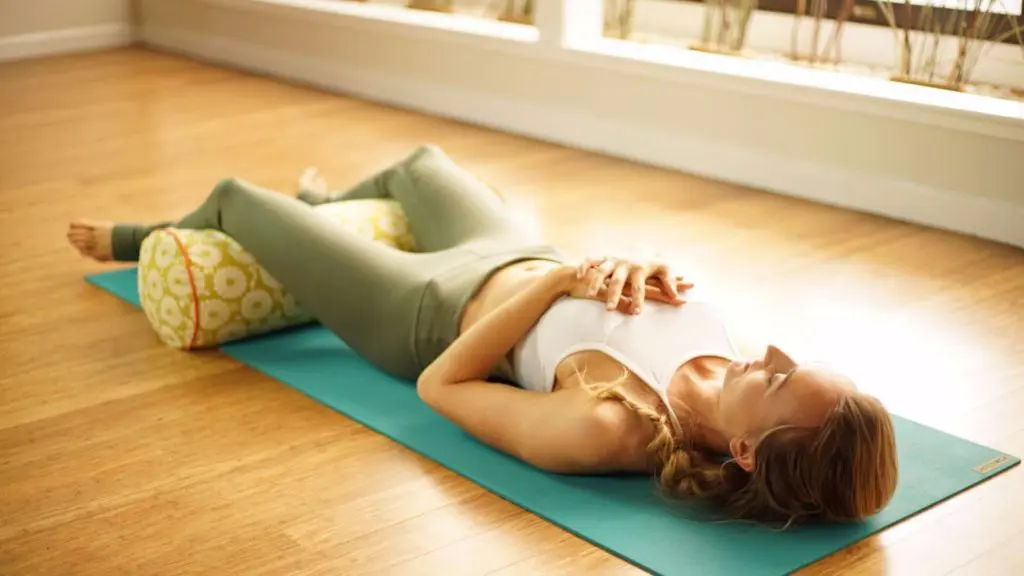As humans, society and our school system condition us to sit still, be quiet, tame and dissociate from our body. We’re taught that being loud and “shaking it off” is wrong. This sends a message not to trust our bodies and we get stuck purely in our heads, forgetting how to process through movement.
But how do we correct this conditioning?
If you practice yoga you are likely already working towards re-establishing that mind-body connection. But traditional yoga can only take you so far. Taking an embodied approach to your asanas forms a greater relationship with your body and the innate wisdom it holds.
What Is Embodiment Yoga?
Embodiment yoga, also referred to as somatic yoga, is a style of yoga that focuses on reconnecting with the body through mindful movement and sensory awareness, emphasizing the experience of being fully present in one’s body rather than achieving perfect poses. Embodiment practices invite you to focus on the entire self, to listen to your physical sensations, emotions, and inner responses, fostering a deeper relationship between mind and body. Embodiment yoga encourages personal exploration over rigid alignment, making it adaptable and beneficial for all levels and body types.
When you take an embodied approach to yoga you go on a journey toward self-discovery and acceptance. An embodied yoga class offers the space to tune into the subtle sensations of the body and release stress, tension, and emotional blocks. This approach is a holistic tool to support mental, emotional, and physical wellness. In embodiment yoga, the goal isn’t achieving a specific shape but rather feeling at home within your own body, leading to greater self-awareness, resilience, and inner peace.
Read more on what is embodiment in this post.
Take my feminine energy quiz to get a recommended practice for balancing YOUR feminine energy 👇
Benefits Of Embodied Yoga
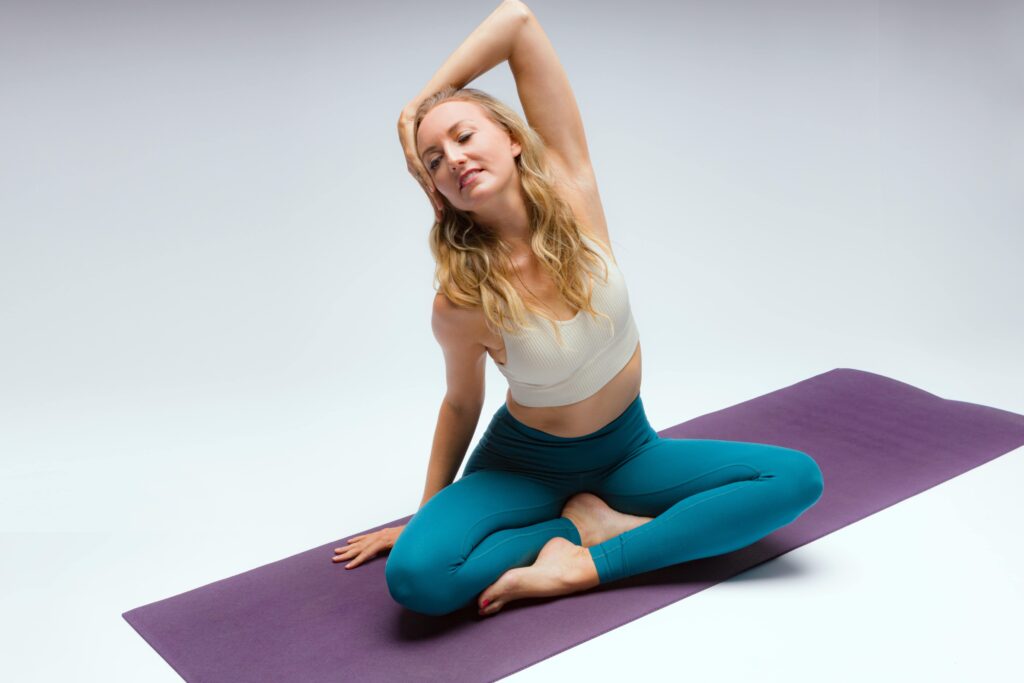
Embodied yoga offers numerous mental and physical benefits, helping you develop a more profound connection with your body and emotions:
- Reduces Stress and Anxiety: Studies show that embodied practices like mindful movement reduce stress and anxiety by activating the parasympathetic nervous system, which helps regulate mood and emotional health
- Mind-body Connection: Practicing embodied yoga helps you become more attuned to physical sensations and emotions, promoting greater self-awareness and emotional intelligence. This aids in recognizing and processing emotional patterns .
- Improves Flexibility and Mobility: By focusing on gentle, mindful movement, embodied yoga helps improve joint mobility and muscle flexibility without pushing the body into rigid poses, which may prevent injury .
- Supports Trauma Healing: Research suggests that somatic practices, including embodied yoga, help release trauma stored in the body by allowing you to feel safe and explore sensations at your own pace .
- Increases Resilience to Stress: Embodiment techniques can improve resilience to stress, helping individuals manage life challenges with greater ease and emotional stability .
Who wouldn’t want to try this holistic approach to well-being after reading this list?! Life is stressful, so its important to have the tools(like embodiment practices) for both mental and physical health.
Somatic Healing Masterclass: Rewire Trauma, Reclaim Your Intuition (usually $67) FREE👇
FREE Feminine Form Embodied Yoga Masterclass (usually $67) Unleashing Pleasure + Intuitive Movement on the Mat
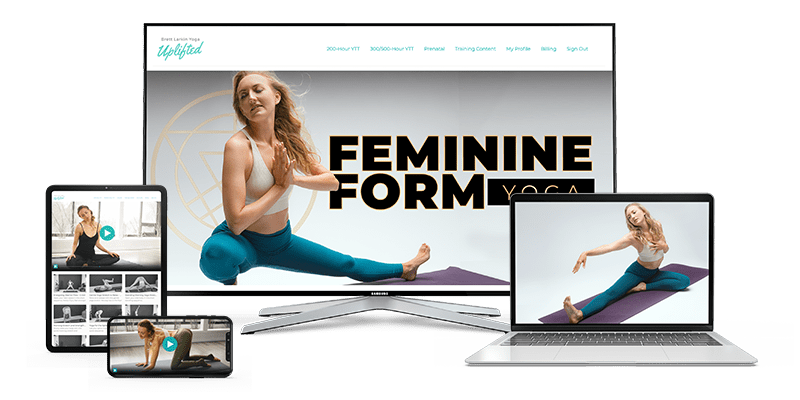
How To Practice Embodied Yoga
Practicing embodied yoga focuses on feeling each movement and sensation with awareness, inviting a deeper connection with your body and inviting your body to move in new ways. Here are some ways to approach an embodied yoga practice:
1. Slow Down and Feel Each Movement
Instead of rushing through poses, move slowly and let each action resonate. Focus on the sensations in your muscles, joints, and breath. For example, when transitioning from one posture to another, notice how your weight shifts and what muscles are activated. Make subtle adjustments in each pose and explore how that feels in your body.
2. Use Breath to Enhance Awareness
Breathe deeply and intentionally, allowing your breath to guide your movements. Inhale as you expand or open in a pose, and exhale to release tension. This approach helps anchor your awareness in the body, calming the mind and enhancing the mind-body connection.
3. Practice Non-Judgmental Awareness
Approach each pose without expectations or self-criticism. Instead of pushing for a certain alignment, explore what feels good and where your body naturally wants to go. This mindset fosters compassion and self-acceptance, key elements of embodied yoga.
4. Incorporate Free Movement
Allow yourself to move freely and intuitively within each pose. For example, in a seated position, gently sway or rock your torso to explore how different movements feel. This freedom encourages a personal connection to each pose and releases habitual tension.
5. End with a Body Scan
After your practice, perform a mental scan of your body, observing areas of relaxation or tension. This body scan reinforces the connection you’ve built and allows you to integrate any insights gained during practice, promoting a sense of calm and feeling grounded.
Give these approaches a try to make embodied yoga a deeply personal practice; nurturing your physical and emotional well-being.
Other embodiment approaches to help increase your body awareness and shift your movement patterns include Laban Movement Analysis or the Alexander Technique. These techniques are popular in the fields of martial arts and dance. If you’d like to explore these further I’d recommend searching for a licensed professional to work with you.
Top Yoga Poses For Embodiment
Here are five yoga poses ideal for practicing embodiment, each designed to encourage a deep mind-body connection and sensory awareness.
You can do these poses on your own, or let me guide you through a somatic yoga sequence with this class:
1. Mountain Pose (Tadasana)
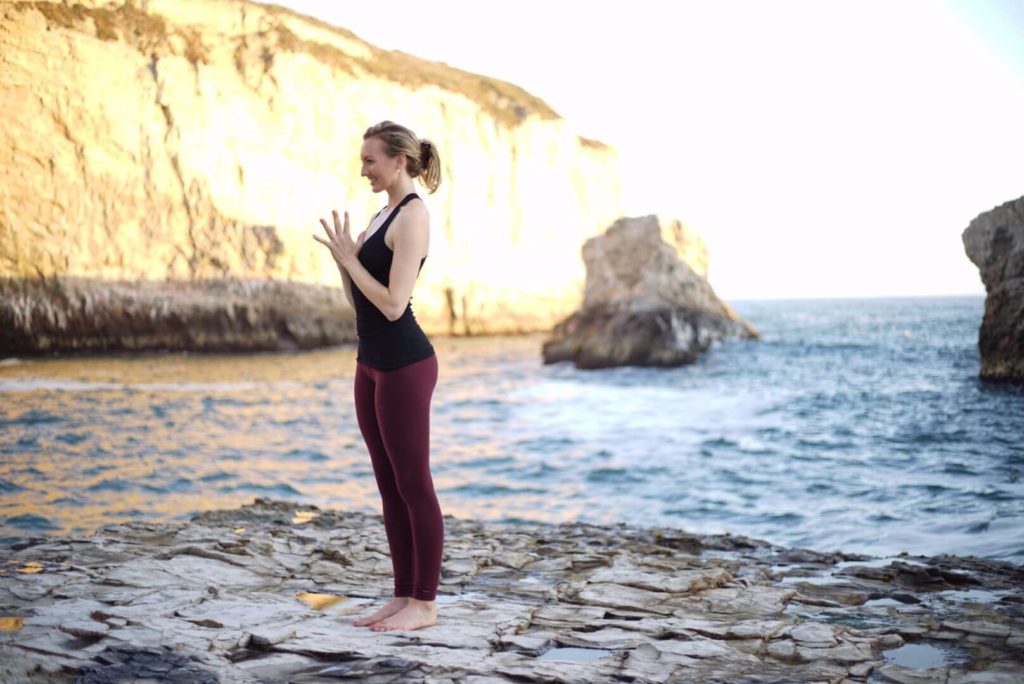
Steps:
- Stand with feet hip-width apart, let your arms rest at your sides.
- Distribute your weight evenly through all four corners of your feet.
- Lengthen through your spine, lifting through the crown of your head.
- Soften your shoulders and engage your core.
Variations: Place hands on your heart or belly to enhance the grounding effect. Place a block between your legs.
Benefits: Increases body awareness, improves posture, and promotes grounding.
Pro Tips for Yoga Teachers:
- Encourage students to notice the sensations in their feet and the stability of their stance.
- Guide them through a body scan from head to toe.
- Lead students into a slow forward fold from here, focusing on the sensations of the body as it changes position.
2. Cat–Cow Stretch (Marjaryasana-Bitilasana)
Steps:
- Start in tabletop(on all fours) with wrists under shoulders and knees under hips.
- Inhale as your back arches (Cow Pose), lifting the head and tailbone.
- Exhale to round the spine (Cat Pose), tucking the chin and tailbone.
Variations: Add gentle hip circles or slow down the movement to explore each phase fully.
Benefits: Promotes spinal mobility and helps release stored tension.
Pro Tips for Yoga Teachers:
- Go super slow to help students feel each vertebra’s movement.
- Try this on all fours and then again seated or in a chair to encourage students to feel into the subtle differences.
- Invite students to close their eyes to deepen their inner awareness, or bring in a visualization.
3. Child’s Pose (Balasana)
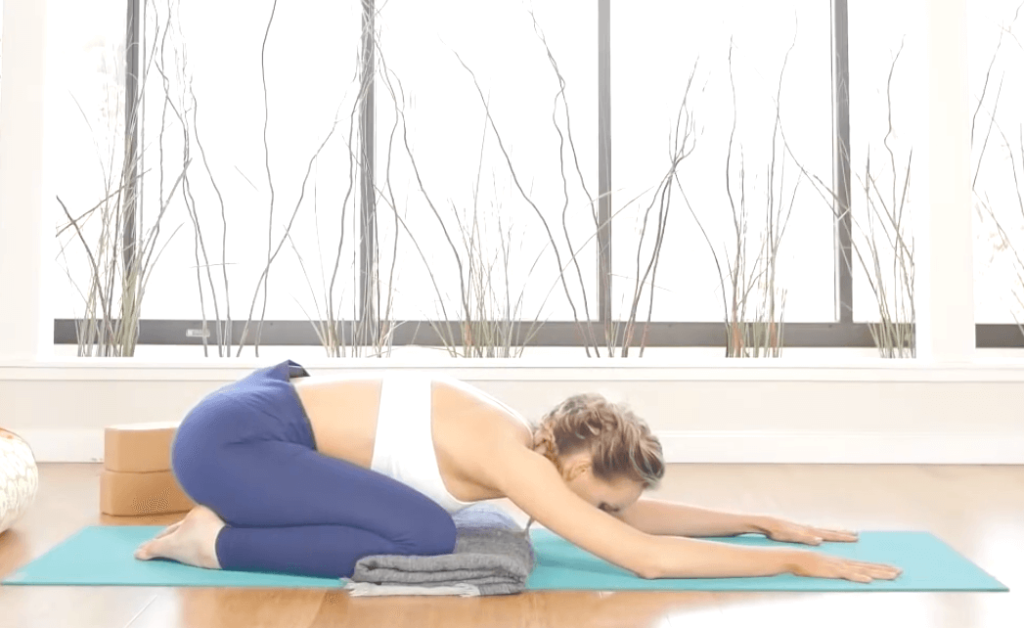
Steps:
- Kneel on the floor, big toes touching, and knees wide.
- Bring your seat to your heels and extend arms forward, resting your forehead on the mat.
- Breathe deeply and allow the body to relax.
Variations: Rest arms by your sides to reduce shoulder strain. Place a cushion under your seat if it doesn’t meet the heels.
Benefits: Calms the mind, releases tension in the back, and encourages a gentle inward focus.
Pro Tips for Yoga Teachers:
- Use Child’s Pose as a rest position throughout the class.
- This is a nice moment to go through some gentle guided breathwork, focusing on the sensations in the body.
- Encourage your students to massage their feet or calves.
4. Supine Twist (Supta Matsyendrasana)
Steps:
- Lie on your back, hug one leg into your chest keeping the other long on the floor.
- As you exhale pull that knee to the opposite side of the body while extending the opposite arm outward.
- Breathe deeply, letting the twist release tension in the lower back.
Variations: Place a pillow under your knee for additional support. Take both knees into the twist rather than one at a time.
Benefits: Releases back tension, stretches the spine, aids digestion and promotes relaxation.
Pro Tips for Yoga Teachers:
- Encourage students to relax fully into each twist.
- Guide them to observe the sensations along their spine and rib cage.
- Allow them to take subtle movements, rolling the wrist or flexing and extended the outstretched leg, for multiple breaths to enhance relaxation.
5. Savasana (Corpse Pose)
Steps:
- Lie on your back with arms and legs relaxed, palms facing up.
- Close your eyes, let the body melt into the ground releasing tension from head to toe.
- Focus on natural breathing, letting go of any remaining tension.
Variations: Use bolsters or blankets under knees or head for added comfort.
Benefits: Encourages complete relaxation and integration of the practice. Activates the parasympathetic nervous system.
Pro Tips for Yoga Teachers:
- Encourage students to scan their bodies, noticing any residual tension.
- Use guided imagery or breath cues to deepen relaxation.
- Offer a longer Savasana with guided regulation to maximize the integration of the embodiment practice.
Each of these poses supports a focused, sensory-based approach to yoga. This type of embodied flow allows the student, and teacher, to build greater body awareness and experience a sense of calm and balance.
Closing Thoughts
Current yoga culture focuses a lot on external alignment. How good your practice “looks”, or what “shapes” you can make. But this is slowly starting to shift. More and more people are learning that the highest yoga is off the mat. That taking the postures as a launching point for intuitive movement brings new aspects of healing. This is why my Somatic Yoga Certification is quickly becoming one of my most popular trainings. If you’re looking for new perspectives to teaching I encourage you to check it out. Or check out my many embodied flows on YouTube.
Next Steps
- Take a deep dive into embodiment and somatic yoga with my Somatic Yoga certification program.
- If you’re interested in practical kriya yoga as a way to improve your daily life and relationships, check out my Yoga for Self Mastery course.
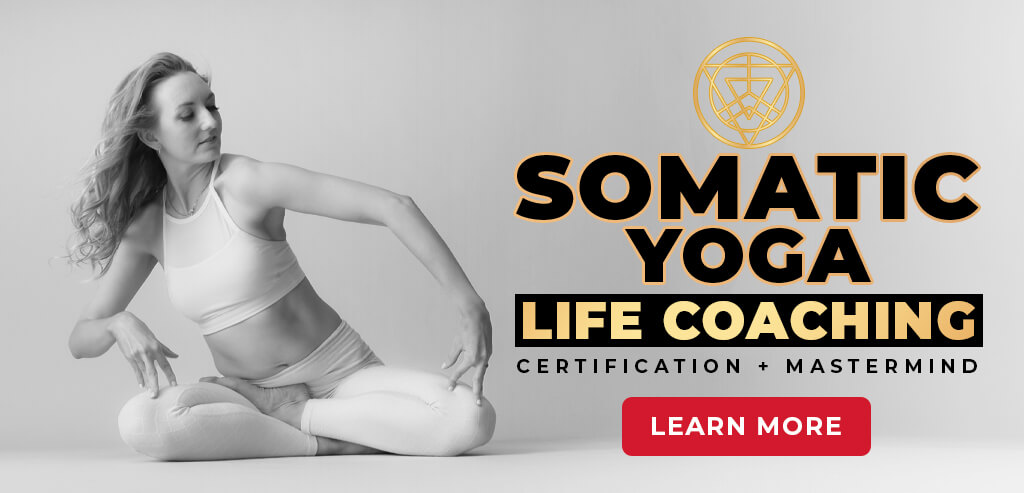
FREE Embodied Yoga Workshop (usually $67) Somatic Techniques & Cord Cutting Ritual
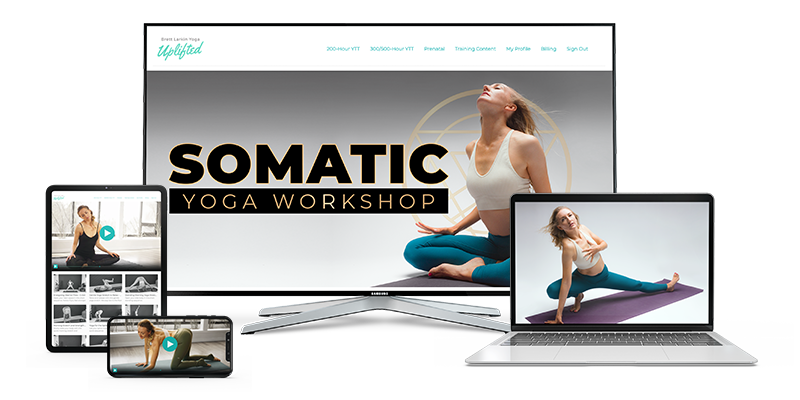
YOU MIGHT ALSO LIKE
- 7 Top Somatic Yoga Books to Regulate Your Nervous System
- 5 Best Somatic Yoga Apps for Nervous System Regulation
- Top Somatic Coaching Programs And How To Choose One
- Somatic Yoga Workshop Ideas for Teachers
- Somatic Yoga for Cortisol Detox: A Gentle Path to Stress Relief and Nervous System Healing
- Gentle Somatic Yoga: Heal Chronic Pain, Release Trauma, and Reclaim Your Bod
- Somatic Meditation: A Body-Based Approach to Healing Stress, Anxiety, and Trauma
- Advanced Pelvic Floor Breathing: A Somatic Approach to Healing
- Somatic Yoga For Yoga Teachers: Everything You Need to Know in 10 Steps
- How Somatic Shaking Can Release Tension and Reset Your Nervous System
- Discover Somatic Pilates: Enhance Your Body Awareness and Flexibility
- Kundalini for Feminine Energy: Ignite Your Creative Power and Passion
- 6 Effective Somatic Yoga for Neck and Shoulders
- How to Teach Somatic Yoga: A Practical Guide for Instructors
- The Best Somatic Exercises for Grief: Find Healing Through Movement
